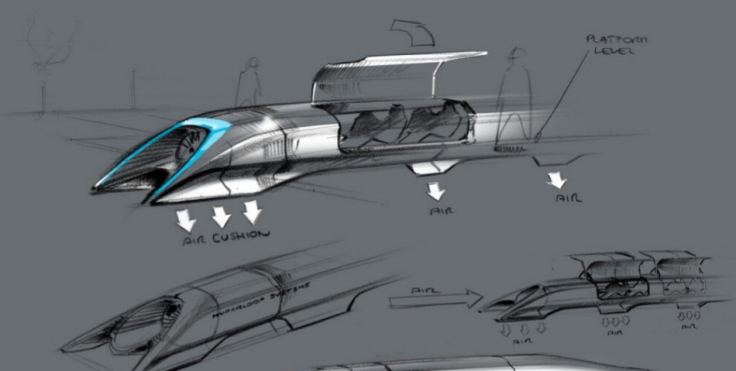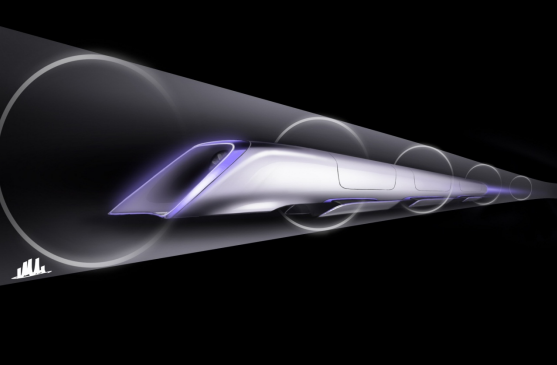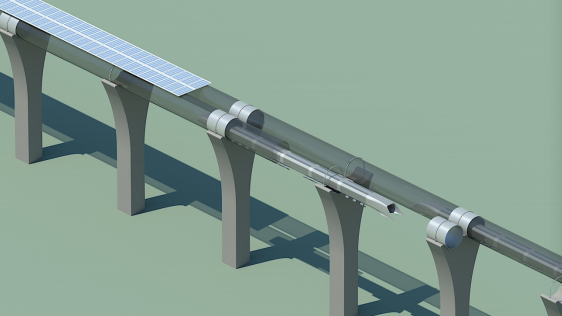Hyperloop Revealed: How Elon Musk Plans to Revolutionise the Railway [VIDEO]
Elon Musk has finally revealed more about his proposed Hyperloop transportation system, which can whisk passengers 300 miles from Los Angeles to San Francisco in 30 minutes at more than 600mph for just $20 (£13).

A mix between a Concorde...
In a blog post, Musk, who has previously co-founded Paypal, Tesla and SpaceX, said the train-like system would sit passengers two-by-two in aluminium pods which would travel at up to 800mph, or slightly more than the speed of sound.
The Hyperloop track would be held aloft on columns between 50 and 100 yards apart, and would mostly follow the route of California's I-5 highway. Musk also revealed that his system could be used to transport cars, estimating the cost would range from $6 billion for the passenger-only version, to $10bn for a Hyperloop capable of carrying cars.

A railgun
The Hyperloop pods would be accelerated using an electromagnet - similar to a railgun, as promised when Musk first spoke about Hyperloop last year - and the process would be reversed to slow the pods down again, absorbing kinetic energy to be stored as electricity and reused.
Musk's plans dictate that a linear electric motor (similar to what Tesla electric cars use) would be needed roughly every 70 miles to give the pods a boost and keep them up to speed. "The...motor is needed for as little as 1% of the tube length, so is not particularly expensive."
Indeed, Musk admits that the pods and a means of powering them are "relatively minor expenses" compared to the cost of constructing the 600-mile long tube (300 miles in each direction), but at "several billion dollars" Musk adds that this would still be much cheaper than the several tens of billions of dollars a conventional high-speed railway would cost.
The US government is currently planning a 130mph high-speed railways between the same two cities, but with an estimated cost of more than $60bn.

...and an air hockey table
One of the biggest mysteries surrounding the Hyperloop project is how it can maintain such a high speed without requiring a massive amount of power; Musk reveals in his plans that the solution is to operate the system in a low pressure environment, which lowers friction without risking the dangers associated with creating (and damaging) a vacuum.
Friction would be further reduced by mounting compressor fans on the front and back of each pod, transferring high pressure air from the front of the pod to the back. "This is like having a pump in the head of the syringe actively relieving pressure," Musk explained, adding that this transfer of air can also be fed underneath the pod and used as its suspension
Below the pods, these 'air bearings' which Musk describes as "the same basic principle as an air hockey table", would allow the pods to travel at up to Mach 1.1 (837mph) with extremely low friction.
Generating enough energy to power these fans would at first seem difficult, but Musk believes this "is not a problem" and battery packs carried by each pod would provide sufficient power, so long as the acceleration and deceleration is done by another means.

Being in a tube (and held above the ground) means Hyperloop can "almost entirely avoid the need to buy land by following alongside the mostly very straight California I-5 highway, with only minor deviations when the highway makes a sharp turn." Musk claims the damage caused to local farmland would be "comparable to a tree or telephone pole, which farmers deal with all the time."
Self-powered
Another claim made by Musk before revealing his full plans was that Hyperloop can be entirely self-sufficient, and this claim is backed up by the newly-published plans. "The short answer is that by placing solar panels on top of the tube, the Hyperloop can generate far in excess of the energy needed to operate." This is also claimed to take into account storing battery packs for use at night and extended periods of cloudy weather.
As for the cost of a ticket, Musk said previously that travelling by Hyperloop would cost less than a plane ticket or driving the same 300-mile journey by car, and his plan claims a single one-way ticket would cost just $20 if a $6bn passenger-only version was constructed.

Capsules would depart as often as every 30 seconds from each terminal and carry 28 people each. This gives a total of 7.4 million people each way that can be transported every year on Hyperloop.
Passengers would be allowed to carry two pieces of luggage weighing no more than 50kg in total, and these would be stored in a separate compartment at the rear of each capsule.
But, as reported last week, Musk has no plans to build Hyperloop himself, but leaving his designs open source for anyone to take up the challenge; however, he added that if no one had built a Hyperloop in a few years' time, then he may consider it.
The entire 57-page PDF can be read here.
© Copyright IBTimes 2025. All rights reserved.






















